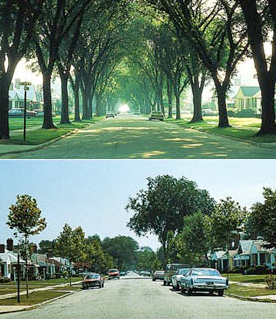Dutch Elm Disease pg.2

Top: Street in Detroit in 1971. Bottom:
Same street in 1984.
Similar control measures elsewhere in northern Europe slowed the spread of the disease in other countries. These areas also had a greater variety of elm species and varieties, some of which had more resistance to the deadly fungus.
Nonetheless, the fungus crossed the Alps and caused a deadly outbreak in Italy. Not only were elms ornamental and shade trees there, but they also provided natural support for great rope and wire trellises of grapevines. The elms died, and as one Italian nurseryman put it, “The vine wedded to the elm has become a widow.” Italian agriculture suffered huge losses.
A shipment of logs to an Ohio furniture factory led to the first noted North American outbreak in 1930. Researchers held a meeting on Dutch elm disease in Washington, D.C., Oct. 26, 1931. The very next day, a new outbreak was reported afflicting 628 trees in New Jersey, 48 in New York and one in Connecticut. Another outbreak was reported from Baltimore.
Elms were the glory of American cities and towns, adorning the parks and creating great tunnels of branches overarching some streets like the nave of a great cathedral.
Elm aficionado Bruce Carley describes it thus:
The interweaving limbs of the stately trees that lined the streets ascended into a towering canopy with a graceful, arching beauty unmatched by any tree that is commonly seen today, spreading horizontally at heights often greatly exceeding 100 feet (in rare cases attaining 140 feet with even greater spreads and 11 foot trunk diameters), and drooping long, slender branches in abundance high above the street, blocking all view of the sky.
